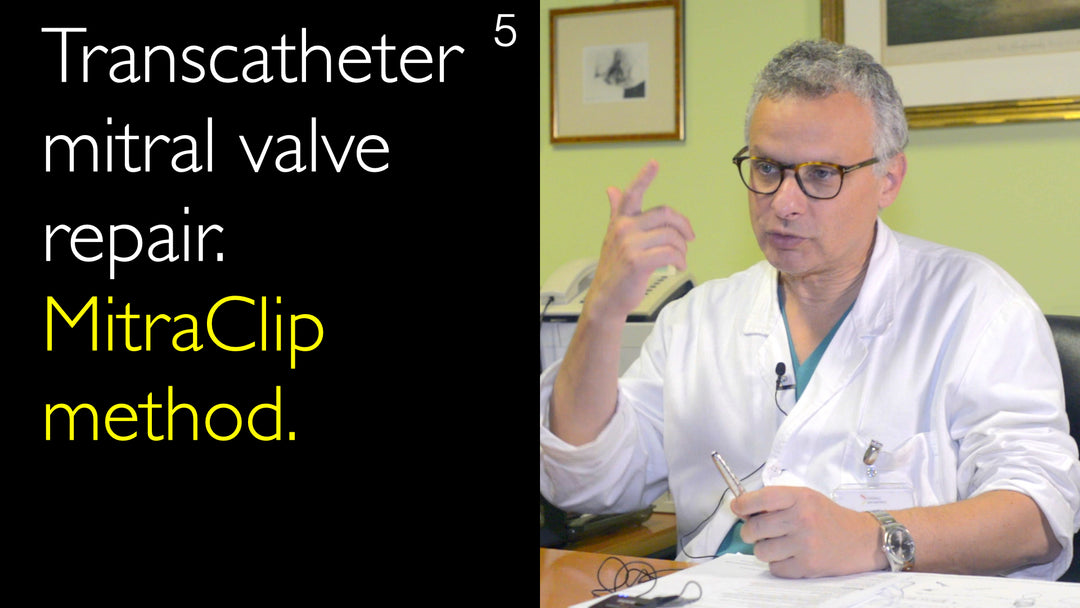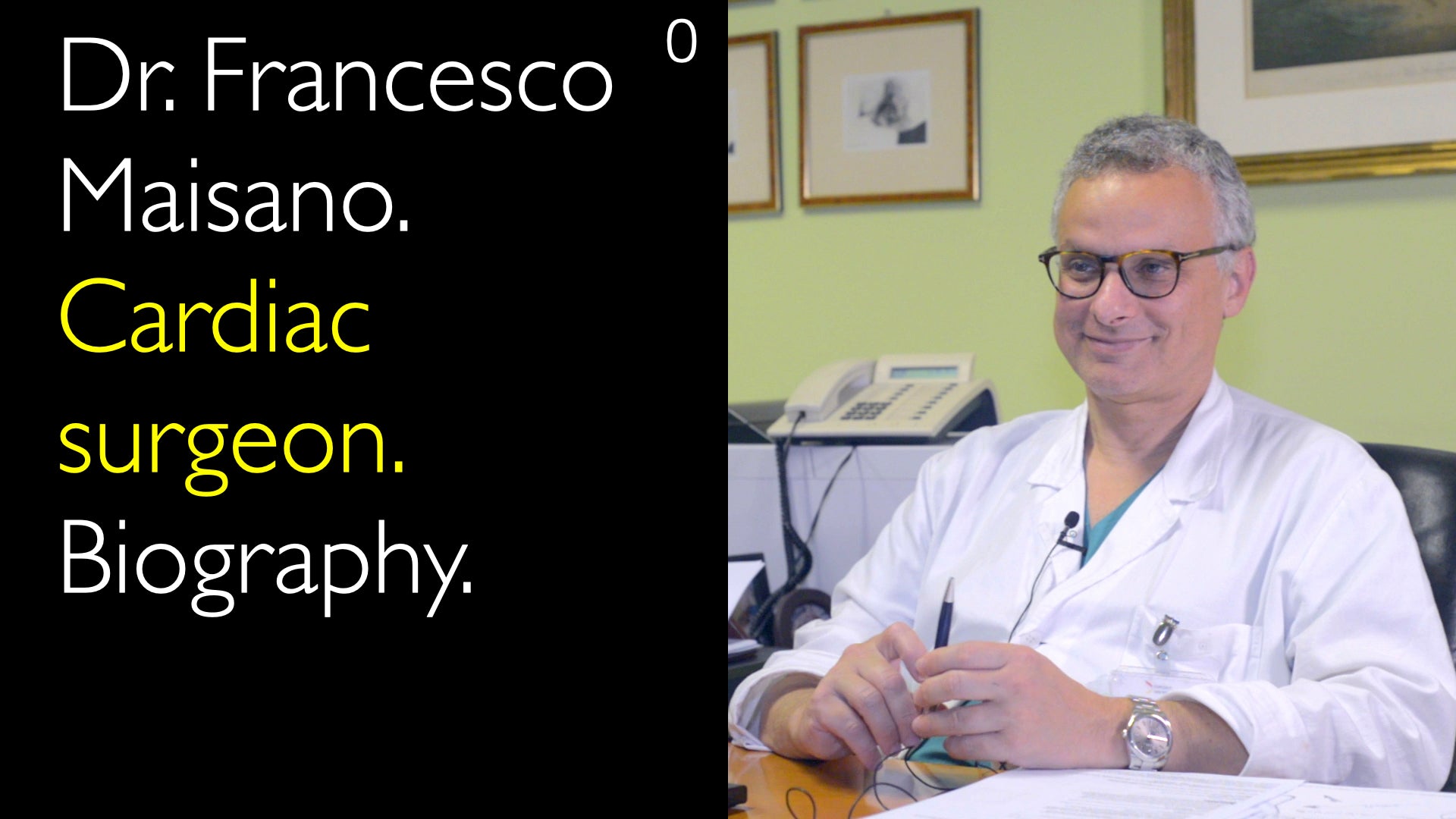מומחה מוביל בתיקון מסתם מיטרלי בצנתור, ד"ר פרנצ'סקו מייזאנו, MD, מסביר את הליך MitraClip. טכניקה פולשנית מינימלית זו מטפלת באי-ספיקה מיטרלית. ד"ר מייזאנו מפרט כיצד ההתקן מדמה שיטה ניתוחית. הוא משווה את MitraClip לאנולופלסטיקה דרך העור. ד"ר פרנצ'סקו מייזאנו, MD, מתאר את היתרונות והמגבלות הנוכחיות של כל גישה עבור פרופילי מטופלים שונים.
תיקון מסתם מיטרלי בצנתור: הליך MitraClip ואפשרויות טבעת (Annuloplasty)
קפיצה לפרק
- מהו הליך MitraClip?
- כיצד פועלת מערכת MitraClip
- יתרונות לעומת ניתוח לב פתוח
- תפקיד הטבעת הפריקוטנית (Percutaneous Annuloplasty)
- השוואת טכניקות MitraClip וטבעת
- כיוונים עתידיים בתיקון מסתם מיטרלי
- תמליל מלא
מהו הליך MitraClip?
תיקון מסתם מיטרלי בצנתור מציע אלטרנטיבה פולשנית מינימלית לניתוח לב פתוח עבור אי-ספיקה מיטרלית. ד"ר פרנצ'סקו מייסנו, MD, מתאר את ה-MitraClip כמכשיר המיועד לבצע תיקון קצה-לקצה בצנתור (TEER). טכניקה זו משחזרת את שיטת אלפיירי הכירורגית, הכרוכה בקירוב שני העלעלים של המסתם המיטרלי.
ההליך הוא רב-שימושי. הוא מטפל ביעילות הן בצניחה ניוונית של המסתם המיטרלי והן באי-ספיקה מיטרלית תפקודית. על ידי חיבור העלעלים יחד עם קליפ, ההליך כופה היצמדות באתר הדליפה, ובכך מבטל את האי-ספיקה.
כיצד פועלת מערכת MitraClip
מכשיר ה-MitraClip הוא בעצם מלחצית המוחדרת לגוף בדרך פריקוטנית. ד"ר פרנצ'סקו מייסנו, MD, מסביר שההליך מתבצע בהרדמה כללית עם הנחיית פלואורוסקופיה ואקוקרדיוגרפיה טרנס-וושטית. הצוות ההתערבותי חוצה את המחיצה הבין-עלייתית כדי להגיע לעלייה השמאלית וממקם את המכשיר מול המסתם המיטרלי.
שתי הזרועות של ה-MitraClip נפתחות בתוך המסתם. המכשיר אז לוחץ את העלעלים המטרה יחד, ומחבר ביניהם. יתרון מרכזי הוא היכולת לבצע את כל התהליך הזה על לב פועם, המאפשר הערכה בזמן אמת של ההשפעה ההמודינמית של התיקון לפני פריסה סופית.
יתרונות לעומת ניתוח לב פתוח
תיקון מסתם מיטרלי בצנתור עם MitraClip מספק יתרונות משמעותיים בהשוואה לניתוח מסורתי. ד"ר פרנצ'סקו מייסנו, MD, מדגיש את האופי ה"מקוון" של ההליך. מנתחים פועלים על לב לא פועם במהלך ניתוח פתוח וצריכים לחזות את תוצאת התיקון. לעומת זאת, הליך ה-MitraClip מספק משוב חזותי והמודינמי מיידי.
הנחיה בזמן אמת זו מאפשרת למפעיל להתאים את ההתערבות לאנטומיה הספציפית של המטופל. אם המיקום הראשוני של הקליפ לא משיג תוצאה אופטימלית, ניתן לשחרר את המכשיר ולמקם אותו מחדש. גישה דינמית זו, המונעת על ידי פיזיולוגיה, יכולה להוביל לתיקונים מדויקים ויעילים יותר עבור פתולוגיות מורכבות של המסתם המיטרלי.
תפקיד הטבעת הפריקוטנית (Percutaneous Annuloplasty)
טבעת פריקוטנית מתייחסת למרכיב שונה של מחלת המסתם המיטרלי. ד"ר פרנצ'סקו מייסנו, MD, מציין שטבעת מיטרלית מורחבת היא ממצא שכיח באי-ספיקה. הרחבה זו יוצרת חוסר התאמה בין גודל הטבעת לרקמת העלעל, המונעת היצמדות נכונה וגורמת לדליפה.
מכשירי טבעת (Annuloplasty) מכוונים להקטנת גודל הטבעת, ומחזירים את האיזון האנטומי התקין. הקטנה זו גם מפחיתה לחץ על מערכת המסתם. ד"ר מייסנו מאמין שלטבעת יש פוטנציאל גדול, במיוחד עבור מטופלים בשלבים המוקדמים של אי-ספיקה מיטרלית תפקודית לפני שמתרחשת שינוי מבני חמור בחדר.
השוואת טכניקות MitraClip וטבעת
הבחירה בין MitraClip לטבעת תלויה בגורמי מטופל ושיקולים פרוצדורליים. ד"ר אנטון טיטוב, MD, וד"ר פרנצ'סקו מייסנו, MD, דנים בהבדלים הקריטיים. MitraClip הוא פתרון רב-שימושי וזמין widely, שניתן לבצעו לרוב מיידית ללא תכנון מקיף לפני ההליך.
טבעת פריקוטנית כרגע מורכבת יותר. היא דורשת לרוב תכנון מוקדם עם CT לב וקשורה בסיכון גבוה יותר לאירועים שליליים, כמו פגיעה בעורק כלילי, עם מכשירים מדור ראשון. עם זאת, טבעת לא משאירה שתל בפתח המסתם, ושומרת על אפשרויות טיפול עתידיות כמו החלפת מסתם, מהווה יתרון משמעותי ארוך טווח.
כיוונים עתידיים בתיקון מסתם מיטרלי
תחום ההתערבות המיטרלית בצנתור מתפתח במהירות. ד"ר פרנצ'סקו מייסנו, MD, צופה שמכשירי טבעת מדור שני יהיו ידידותיים יותר למפעיל ובטוחים יותר. התקדמות זו יכולה לקבוע את הטבעת כפתרון מוביל למחלה בשלב מוקדם.
יישומים עתידיים עשויים להתרחב כדי לכלול טיפול באי-ספיקה תפקודית הן במסתם המיטרלי והן בטריקוספידלי, במיוחד במטופלים עם הרחבה עלייתית. שילוב של טכניקות, כמו טבעת ואחריה קליפ או החלפת מסתם, מייצג גישה הוליסטית המותאמת אישית למטופל לטיפול במחלת מסתם לב מורכבת ללא ניתוח פתוח.
תמליל מלא
ד"ר אנטון טיטוב, MD: צניחת מסתם מיטרלי מטופלת לרוב בניתוח לב פתוח. אך לאחרונה, הופיעו גם שיטות פולשניות מינימליות לתיקון מסתם מיטרלי בצנתור. זהו טיפול מבטיח מאוד עבור אי-ספיקה מיטרלית. הצוות שלך, יחד עם פרופ' אוטאביו אלפיירי, פיתח שיטה פריקוטנית ספציפית לתיקון מסתם מיטרלי. היא נקראת MitraClip. מהו MitraClip וכיצד להשתמש ב-MitraClip בטיפול הפולשני המינימלי בצניחת מסתם מיטרלי?
ד"ר פרנצ'סקו מייסנו, MD: קודם כל, MitraClip מתוכנן לשחזר את מה שנקרא טכניקת אלפיירי. היום,我们应该谈论经导管边对边修复,或TEER。这是当今治疗指南中的名称,因为经导管边对边修复可以在同一次手术中用不同的技术完成。
MitraClip היא שיטה אחת, שהייתה בשימוש mostly היום. Pascal הוא מכשיר דומה לתיקון מסתם מיטרלי בצנתור, העושה את אותה גישה. זהו קירוב שני העלעלים של המסתם המיטרלי. עלעל אחד של המסתם המיטרלי נע יותר מדי או פחות מדי, אז או שזו צניחה או שזו משיכה.
אתה יכול לשים את שני העלעלים יחד, לחבר אותם עם מכשיר אחד, שהוא קליפ, אבזם, או whatever. Then you try to put the two valvular leaflets together. In this way, you obtain the coaptation of mitral valve leaflets. You force the coaptation at the site of the mitral valve regurgitation. This is the concept of the Alfieri technique of mitral valve repair.
לטכניקת אלפיירי יש יתרון עצום על פני כל טכניקה אחרת של תיקון מסתם מיטרלי. שיטת התיקון קצה-לקצה של אלפיירי היא כל כך רב-שימושית. היא יכולה לשמש בצניחת מסתם מיטרלי. היא יכולה לשמש באי-ספיקה מיטרלית תפקודית. זה לא משנה מה קורה מתחת למסתם המיטרלי. העלעלים של המסתם מחוברים יחד, וזה יוצר את הפתרון.
MitraClip פותח בתחילת שנות ה-2000. הוא פותח during the late 1990s. They started the evolution of the development of this technology. It is, basically, a clamp. It is a clamp that clamps the two valvular leaflets together.
המלחצית מוחדרת לגוף under fluoroscopic and echocardiography guidance. The patient will be in general anesthesia with transesophageal echocardiography. It will be producing the images that we will use for the implantation of the MitraClip. We cross the septum. We get into the left atrium. We go in front of the mitral valve, we open the MitraClip clamp.
ה-MitraClip עשוי basically משתי זרועות, which are opened with this device. It goes into the inside of the mitral valve, it clamps the leaflets. The MitraClip is closed, the leaflets are approximated, and they are joined together. All this is done under physiologic conditions. And that's the beauty of it.
Compared to open-heart surgery, where we operate on a non-beating heart, we can do things that are fantastic, but we need to be very smart. We need to predict how this anatomy will react to beating heart conditions. So we cannot see the effect of our intervention until we close the heart and wean the patient from a cardiopulmonary bypass machine.
ב-MitraClip, הכל נעשה on a beating heart, online. What you do is what you get. You see immediately the effect of your action. And you can adapt MitraClip to the patient's condition and patient's anatomy. If you don't like the effect, you can release the MitraClip clamp and start in another position. You are guided during these decisions by the hemodynamic effects of your MitraClip implantation.
To some extent, it is a simplification of surgery. To some extent, it is even more than surgery. It is a very hemodynamically-driven intervention. That also requires quite a lot of experience to make the right decisions during MitraClip transcatheter mitral valve repair.
ד"ר אנטון טיטוב, MD: Also, there is an opportunity to do MitraClip. But there is another technique called percutaneous annuloplasty. What are the advantages and disadvantages of MitraClip and percutaneous annuloplasty? How do you compare these techniques and apply them to the right patient with mitral regurgitation?
ד"ר פרנצ'סקו מייסנו, MD: Annuloplasty. I have been developing one of the tools to reduce the size of the annulus of mitral valve. First of all, annuloplasty is a surgical technique that is done in every mitral valve repair in open surgery or minimally invasive surgery. So it is very commonly done.
הסיבה היא שהטבעת, which is basically connected at the base of the heart, is found dilated in almost every patient with mitral valve regurgitation. For this reason, there is a need to reduce the size of the mitral valve annulus because there is a mismatch between the size of the valvular annulus and the size of the valve leaflets.
הטבעת כל כך מורחבת that the leaflets cannot touch each other anymore in the middle. This has two consequences. One consequence is mitral valve regurgitation. They don't touch. The second consequence is that there is a lot of stress on this difference.
Even if you join them, let's say with the MitraClip, you can create a lot of tension there. Eventually, you may break or you may damage the valvular leaflets. This also happens in surgery. If you do a procedure without annuloplasty, the tension remains there. And you can have a tear of your reconstruction of the mitral valve.
For this reason, by using the annuloplasty, you bring the leaflets together, you re-establish a good balance between the size of the annulus and the size of the mitral valve leaflets. And then you reduce the stress on the system. So, annuloplasty, in principle, could be done in most of the functional mitral regurgitation patients.
Specifically, it can be done in the early stages before the ventricle becomes very dilated. Because in the early mitral valve regurgitation phase, the mitral valve leaflets are still not too much pulled down into the left ventricle. I still believe that in the future, annuloplasty could become the leading solution for those patients undergoing procedures early in their disease stage.
היתרון האחר של טבעת is that it gives a very little footprint. In MitraClip, or any clip-in device will stay in the middle of the heart valve. This will be creating anatomy which may prevent other treatment options like mitral valve replacement. We already have solutions for that, but in principle, it makes things more difficult.
ניתוח תיקון הטבעת (annuloplasty) הוא רק צמצום והחזרה לנורמה של הטבעת. אז בעיקרון, אפשר לעשות הכל אחריו. אפשר להשתיל קליפ. אפשר להשתיל שסתום מלאכותי. כבר ביצענו מקרים רבים. אז, אלה היתרונות.
החיסרון העיקרי של תיקון הטבעת בצנתור (transcatheter annuloplasty) כיום הוא המורכבות של ההליך. הדימות אינו אידיאלי מספיק להליכים אלה. מכשירי תיקון הטבעת בצנתור עדיין בדור הראשון. הדור השני עדיין לא הגיע.
ברגע שיהיה לנו הדור השני, כנראה שהם יהפכו ליותר ידידותיים למפעיל ולכן גם בטוחים יותר. כרגע, בגלל הקושי בדימות, בגלל הקושי בהפעלת תיקון הטבעת בצנתור, עדיין יש יותר מדי אירועים שליליים.
יש לנו יותר מדי מקרים של פגיעה בעורקים הכליליים. יש לנו יותר מדי מקרים של השתלה לא מספקת של מכשיר תיקון הטבעת. יש לנו גם כמה מקרים של תוצאות תת-מיטביות. אז תיקון הטבעת בצנתור עדיין אינו הפתרון לכל מטופל.
והמגבלה הנוספת של תיקון הטבעת כיום היא זו. אם מטופל מגיע לבית החולים כמצב חירום, ואם אני צריך לעשות משהו עכשיו, אני יכול לבצע הליך MitraClip מייד. אני לא צריך תכנון טרום-הליך. תיקון הטבעת בצנתור דורש, כרגע, תכנון עם CT לב לפני ההתערבות.
אז הזמינות של תיקון הטבעת היא מגבלה נוספת. זה דומה לתיקון הטבעת ולהחלפת שסתום מיטרלי. אבל שוב, בעתיד, לא אתפלא אם תיקון הטבעת יהפוך ליותר ויותר בשימוש בצורות האטריות.
קודם כל, יש מטופלים רבים עם חדר שמאל תקין ופרוזדורים גדולים. וזה יכול לשמש הן בשסתום המיטרלי והן בשסתום הטריקוספידלי. תיקון הטבעת יכול לשמש גם באי-ספיקה מיטרלית תפקודית או באי-ספיקה טריקוספידלית במטופלים בשלבים המוקדמים של צניחת שסתום מיטרלי, כאשר אין משיכה רבה של עלי השסתום.








